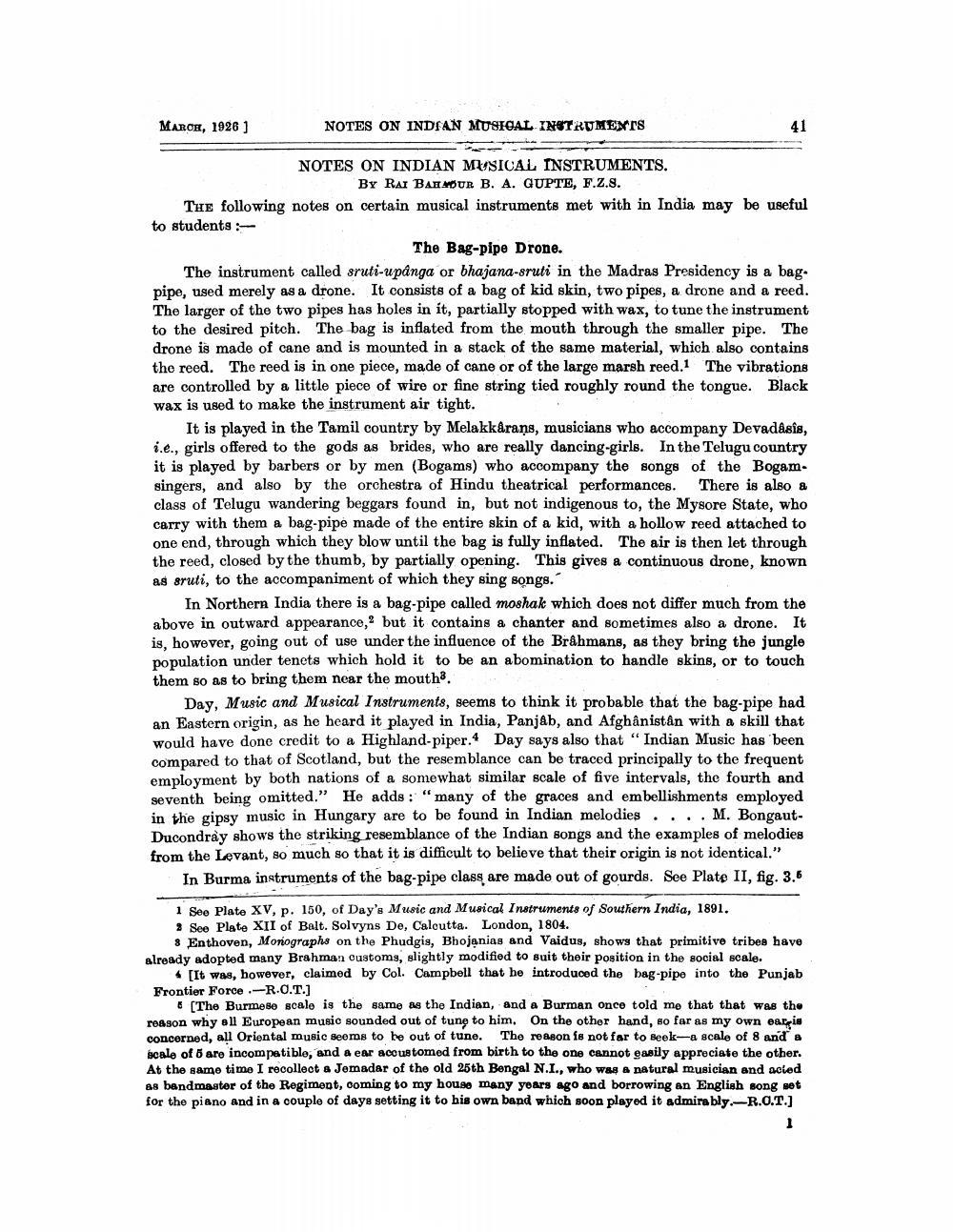________________
MAROH, 1926 1
NOTES ON INDIAN MUSICAL INSTRUMENTS
NOTES ON INDIAN MUSICAL INSTRUMENTS.
BY RAI BAHMUR B. A. GUPTE, F.Z.8. THE following notes on certain musical instruments met with in India may be useful to students
The Bag-pipe Drone. The instrument called sruti-upanga or bhajana-sruti in the Madras Presidency is a bag, pipe, used merely as a drone. It consists of a bag of kid skin, two pipes, a drone and a reed. The larger of the two pipes has holes in it, partially stopped with wax, to tune the instrument to the desired pitch. The bag is inflated from the mouth through the smaller pipe. The drone is made of cane and is mounted in a stack of the same material, which also contains the reed. The reed is in one piece, made of cane or of the large marsh reed. The vibrations are controlled by a little piece of wire or fine string tied roughly round the tongue. Black wax is used to make the instrument air tight.
It is played in the Tamil country by Melakkârans, musicians who accompany Devadasis, i.e.. girls offered to the gods as brides, who are really dancing-girls. In the Telugu country it is played by barbers or by men (Bogams) who accompany the songs of the Bogamsingers, and also by the orchestra of Hindu theatrical performances. There is also a class of Telugu wandering beggars found in, but not indigenous to, the Mysore State, who carry with them a bag pipe made of the entire skin of a kid, with a hollow reed attached to one end, through which they blow until the bag is fully inflated. The air is then let through the reed, closed by the thumb, by partially opening. This gives a continuous drone, known as sruti, to the accompaniment of which they sing songs.
In Northern India there is a bag-pipe called moshak which does not differ much from the above in outward appearance, but it contains a chanter and sometimes also a drone. It is, however, going out of use under the influence of the Bråhmans, as they bring the jungle population under tenets which hold it to be an abomination to handle skins, or to touch them so as to bring them near the mouth.
Day, Music and Musical Instruments, seems to think it probable that the bag-pipe had an Eastern origin, as he heard it played in India, Panjab, and Afghanistan with a skill that would have done credit to a Highland-piper.4 Day says also that "Indian Music has been compared to that of Scotland, but the resemblance can be traced principally to the frequent employment by both nations of a somewhat similar scale of five intervals, the fourth and seventh being omitted.” He adds: "many of the graces and embellishments employed in the gipsy music in Hungary are to be found in Indian melodies.... M. BongautDucondray shows the striking resemblance of the Indian songs and the examples of melodies from the Levant, so much so that it is difficult to believe that their origin is not identical."
In Burma instruments of the bag-pipe class are made out of gourds. See Plate II, fig. 3.6
1 See Plate XV, p. 150, of Day's Music and Musical Instruments of Southern India, 1891. > See Plate XII of Balt. Solvyns De, Caloutta. London, 1804.
8 Enthoven, Monographs on the Phudgis, Bhojanias and Vaidus, shows that primitive tribes have already adopted many Brahman Customs, slightly modified to suit their position in the social scale.
4 [It was, however, claimed by Col. Campbell that he introduced the bag-pipe into the Punjab Frontier Force.-R.O.T.]
& (The Burmese scale is the same as the Indian, and a Burman once told me that that was the reason why all European music sounded out of tune to him. On the other hand, so far as my own earris concerned, all Oriental music seems to be out of tune. The reason is not far to seek-a scale of 8 and a scale of 5 are incompatible, and a ear acoustomed from birth to the one cannot easily appreciate the other. At the same time I recollect a Jemadar of the old 25th Bengal N.I., who was a natural musician and acted as bandmaster of the Regiment, coming to my house many years ago and borrowing an English song set for the piano and in a couple of days setting it to his own band which soon played it admirably.-R.O.T.)




